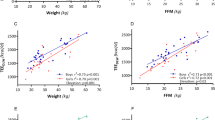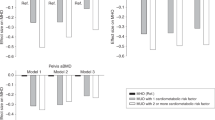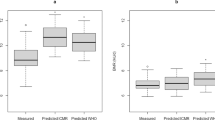Abstract
BACKGROUND: There are limited and controversial data on the influence of gender on metabolic rate in prepubertal children.
OBJECTIVE: To assess the effect of gender on resting energy expenditure (REE), activity-related energy expenditure (AEE), total energy expenditure (TEE) and physical activity level (PAL) in free-living prepubertal children.
DESIGN: Cross-sectional study.
SUBJECTS: 40 prepubertal children (24 boys, 16 girls, 4–11 y old (mean age: 7.0±1.2 y), BMI 13.1–32.0 kg/m2).
MEASUREMENTS: Energy expenditure was measured by the combination of indirect calorimetry and individually calibrated 24 h heart rate monitoring. Body composition was assessed by anthropometrics and bioelectrical impedance analysis. Socio-cultural and socio-economic factors, as well as activities of daily living, were estimated by questionnaire for the parents. Boys and girls were matched for fat-free mass (FFM, boys: 25.9±8.5 kg; and girls: 24.4±4.5 kg, n.s.) and fat mass (FM, boys: 11.6±5.9 kg; and girls: 10.8±3.3 kg, n.s.).
RESULTS: We found no sex difference in REE, AEE and TEE. PAL was 1.4±0.3 for boys and 1.2±0.4 for girls. REE and TEE were significantly related to FFM (r=0.62, r=0.81, r=0.60). FFM was found to be the most significant determinant of REE (r2=0.70). REE accounted for the largest part of the variance in TEE (r2=0.46). Gender had no significant effect.
CONCLUSIONS: There is no effect of gender on energy expenditure in prepubertal children.
This is a preview of subscription content, access via your institution
Access options
Subscribe to this journal
Receive 12 print issues and online access
$259.00 per year
only $21.58 per issue
Buy this article
- Purchase on Springer Link
- Instant access to full article PDF
Prices may be subject to local taxes which are calculated during checkout



Similar content being viewed by others
References
Ferraro R, Lillioja S, Fontvieille AM, Rising R, Bogardus C, Ravussin E . Lower sedentary metabolic rate in women compared with men J Clin Invest 1992 90 (3): 780–784.
Torun B, Davies PS, Livingstone MB, Paolisso M, Sackett R, Spurr GB . Energy requirements and dietary energy recommendations for children and adolescents 1 to 18 years old Eur J Clin Nutr 1996 50 (Suppl 1): S37–S80.
Fontvielle AM, Harper IT, Ferraro RT, Spraul M, Ravussin E . Daily energy expenditure by five-year-old children, measured by doubly labeled water J Pediatr 1993 123 (2): 200–207.
Emons HJG, Groenenboom DC, Westerterp KR, Saris WHM . Comparison of heart rate monitoring combined with indirect calorimetry and the doubly labelled water (2H218O) method for the measurement of energy expenditure in children Eur J Appl Physiol 1992 65: 99–103.
Livingstone MBE, Coward WA, Prentice AM, Davies PSW, Strain JJ, McKenna PG, Mahoney CA, White JA, Stewart CM, Kerr MJJ . Daily energy expenditure in free-living children: comparison of heart-rate with doubly labeled water (2H218O) method Am J Clin Nutr 1992 56: 343–352.
Maffeis C, Schutz Y, Micciolo R, Zoccante L, Pinelli L . Resting metabolic rate in six- to ten-year-old obese and nonobese children J Pediatr 1993 122 (4): 556–562.
Goran MI, Carpenter WH, Poehlman ET . Total energy expenditure in 4- to 6 yr-old children Am Physiol Soc 1993 264: E706–E711.
Bitar A, Vermorel M, Fellmann N, Coudert J . Twenty-four-hour energy expenditure and its components in prepubertal children as determined by whole-body indirect calorimetry and compared with young adults Am J Clin Nutr 1995 62:: 308–315.
Black AE . Human energy expenditure in affluent societies: an analysis of 574 doubly-labelled water measurements Eur J Clin Nutr 1996 50: 72–92.
Goran MI, Nagy TR, Gower BA, Mazariegos M, Solomons N, Hood V, Johnson R . Influence of sex, seasonality, ethnicity, and geographic location on the components of total energy expenditure in young children: implications for energy requirements Am J Clin Nutr 1998 68: 675–682.
Greene LC, Livingstone MBE, McGloin AF, Webb SE, Jebb SA, Prentice AM . Daily energy expenditure in free-living children: comparison of Caltric motion sensors with the doubly-labelled water method (Abstract) Procl Nutr Soc 1994 53: 207–221.
Trost SG, Pate RR, Sannders R, Ward DS, Felton G . Gender differences in physical activity and determinants of physical activity in rural fifth grade children J School Health 1996 66: 145–150.
Johnson RK, Russ J, Goran MI . Physical activity related energy expenditure in children by doubly labelled water as compared with the Caltrac accelerometer Int J Obes 1998 22: 1046–1052.
Müller MJ . Ernährungsmedizinische Praxis. Springer: Berlin 1998.
Mast M, Körtzinger I, König E, Müller MJ . Gender differences in fat mass of 5–7 year old children Int J Obes 1998 22: 878–884.
Goran MI, Driscoll P, Johnson R, Nagy TR, Hunter G . Cross-calibration of body composition techniques against dual-energy x-ray absorptiometry in young children Am J Clin Nutr 1996 63: 299–305.
Müller MJ, von zur Mühlen A, Lautz HU, Schmidt FW, Daiber M, Hürter P . Energy expenditure in children with type 1 diabetes: evidence for increased thermogenesis Br Med J 1989 299: 487–491.
World Health Organization . Energy and protein requirements. Report of a Joint FAO/WHO/UNU Expert Consultation 1995.
Livingstone MBE . Heart-rate monitoring: the answer for assessing energy expenditure and physical activity in population studies? Br J Nutr 1997 78: 869–871.
Neumann G, Schüler KP . Sportmedizinische Funktionsdiagnostik. Ambrosius Borth, 1994.
Astrand I . Maximale O2-Aufnahme in Beziehung zum Körpergewicht bei 4–33 jährigen Menschen weiblichen und männlichen Geschlechts. In Mellerowicz H (ed) Der Kreislauf des Jugendlichen bei Arbeit und Sport. Karger: Berlin, 1981 pp 27–29.
Spurr GB, Prentice PD, Murgatroyed PR, Goldberg MS, Reina JC, Christman NT . Energy expenditure from minute-by-minute heart rate recording: comparison with ndirect calorimetry Am J Clin Nutr 1988 48: 552–559.
Schulz S, Westerterp KR, Brück K . Comparison of energy expenditure by the doubly labeled water technique with energy intake, heart rate, and activity recording in man Am J Clin Nutr 1989 49: 1146–1154.
Manios Y, Kafatos A, Cordington C . Gender differences activity and physical fitness in young children in Crete. J Sports Med Phys Fitness 1999 39: 24–30.
Dietz WH, Gortmaker L . Do we fatten our children at the television set? Obesity and television viewing in children and adolescents Pediatrics 1985 75 (5): 807–811.
Jeffery RW, French SA . Epidemic obesity in the United States: are fast food and television viewing contributing? Am J Public Health 1998 88 (2): 277–280.
Müller MJ, Körtzinger I, Mast M, König E . Prävention der Adipositas. Deutsches Ärzteblatt 1998 34/35: 1518–1521.
Goran MI, Reyholds KD, Lindguist CH . Role of physical activity in the prevention of obesity in children Int J Obes 1999 23 (Suppl 2): 18–33.
Acknowledgements
This work was supported by grants from Verein zur Förderung der Rehabilitationsforschung in Schleswig-Holstein e.V., Lübeck; Wirtschaftliche Vereinigung Zucker, Bonn; Else Kröner-Fresenius Stiftung, Bad Homburg; Bad Schwartau Werke, Bad Schwartau; team success, Selent; and Hansa-Tiefkühlmenü GmbH & Co., Hilter.
Author information
Authors and Affiliations
Corresponding author
Rights and permissions
About this article
Cite this article
Grund, A., Vollbrecht, H., Frandsen, W. et al. No effect of gender on different components of daily energy expenditure in free living prepubertal children. Int J Obes 24, 299–305 (2000). https://doi.org/10.1038/sj.ijo.0801127
Received:
Revised:
Accepted:
Published:
Issue Date:
DOI: https://doi.org/10.1038/sj.ijo.0801127
This article is cited by
-
Multi-year lactation and its consequences in Bornean orangutans (Pongo pygmaeus wurmbii)
Behavioral Ecology and Sociobiology (2013)
-
Determinants of resting energy expenditure in obese and non-obese children and adolescents
Journal of Physiology and Biochemistry (2002)



